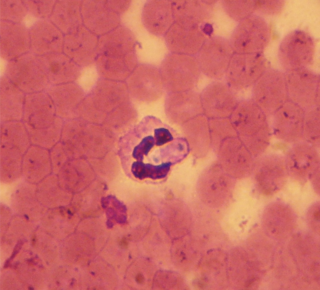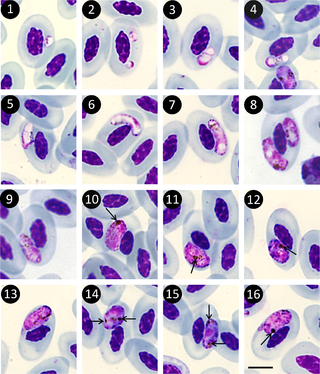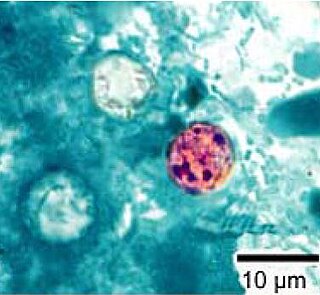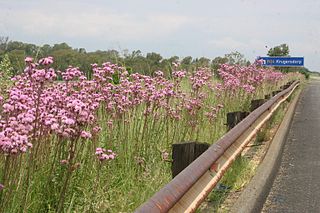
Plasmodium is a genus of unicellular eukaryotes that are obligate parasites of vertebrates and insects. The life cycles of Plasmodium species involve development in a blood-feeding insect host which then injects parasites into a vertebrate host during a blood meal. Parasites grow within a vertebrate body tissue before entering the bloodstream to infect red blood cells. The ensuing destruction of host red blood cells can result in malaria. During this infection, some parasites are picked up by a blood-feeding insect, continuing the life cycle.

Monogeneans, members of the class Monogenea, are a group of ectoparasitic flatworms commonly found on the skin, gills, or fins of fish. They have a direct lifecycle and do not require an intermediate host. Adults are hermaphrodites, meaning they have both male and female reproductive structures.

Hepatozoon is a genus of Apicomplexa alveolates which incorporates over 300 species of obligate intraerythrocytic parasites. Species have been described from all groups of tetrapod vertebrates, as well as a wide range of haematophagous arthropods, which serve as both the vectors and definitive hosts of the parasite. By far the most biodiverse and prevalent of all haemogregarines, the genus is distinguished by its unique reciprocal trophic lifecycle which lacks the salivary transmission between hosts commonly associated with other apicomplexans. While particularly prevalent in amphibians and reptiles, the genus is more well known in veterinary circles for causing a tick-borne disease called hepatozoonosis in some mammals.

Echinostoma is a genus of trematodes (flukes), which can infect both humans and other animals. These intestinal flukes have a three-host life cycle with snails or other aquatic organisms as intermediate hosts, and a variety of animals, including humans, as their definitive hosts.

Blastocladiomycota is one of the currently recognized phyla within the kingdom Fungi. Blastocladiomycota was originally the order Blastocladiales within the phylum Chytridiomycota until molecular and zoospore ultrastructural characters were used to demonstrate it was not monophyletic with Chytridiomycota. The order was first erected by Petersen for a single genus, Blastocladia, which was originally considered a member of the oomycetes. Accordingly, members of Blastocladiomycota are often referred to colloquially as "chytrids." However, some feel "chytrid" should refer only to members of Chytridiomycota. Thus, members of Blastocladiomycota are commonly called "blastoclads" by mycologists. Alternatively, members of Blastocladiomycota, Chytridiomycota, and Neocallimastigomycota lumped together as the zoosporic true fungi. Blastocladiomycota contains 5 families and approximately 12 genera. This early diverging branch of kingdom Fungi is the first to exhibit alternation of generations. As well, two (once) popular model organisms—Allomyces macrogynus and Blastocladiella emersonii—belong to this phylum.

Haemoproteus is a genus of alveolates that are parasitic in birds, reptiles, and amphibians. Its name is derived from Greek: haima 'blood' and Proteus, a sea god that had the power to assume various shapes. The name Haemoproteus was first used in the description of H. columbae in the blood of the pigeon Columba livia by Walther Kruse in 1890. This was also the first description of this genus. Two other genera—Halteridium and Simondia—are now considered to be synonyms of Haemoproteus.

Adeleorina is a suborder of parasites in the phylum Apicomplexa.
Syndinium is a cosmopolitan genus of parasitic dinoflagellates that infest and kill marine planktonic species of copepods and radiolarians. Syndinium belongs to order Syndiniales, a candidate for the uncultured group I and II marine alveolates. The lifecycle of Syndinium is not well understood beyond the parasitic and zoospore stages.
Haemosporidiasina (Haemosporidia) is a subclass of apicomplexans described by Jacques Euzéby in 1988. The taxon is very similar to Aconoidasida.

The Haemoproteidae are a family of parasitic alveolates in the phylum Apicomplexa.

Cyclospora is a genus of apicomplexan parasites. It includes the species Cyclospora cayetanensis, the causative agent of cyclosporiasis. Members of Cyclospora are characterized as having oocysts with two sporocysts, each containing two sporozoites.

Rhabdias bufonis is a species of parasitic nematode in the family Rhabdiasidae. It was first described from the lungs of the European common toad (Bufo bufo) but has also been found in a number of other species of frog.
The Platyproteum are a genus of parasitic alveolates in the phylum Apicomplexa. Species in this genus infect marine invertebrates.

Eupatorium macrocephalum Less. aka pompom weed, is a cosmopolitan perennial plant belonging to the family of Asteraceae and regarded as an invasive weed in some countries. It is native to the southern United States, Central America, South America and was introduced to South Africa. It is classed as a principal weed in Brazil. In South Africa it has been cultivated as an ornamental, is often found on roadsides, and has become of concern for its invading of undisturbed climax grassland and wetlands since the 1960s. It is closely related to Siam weed, and is one of some 268 species in the genus.

Echinophthiriidae is a family of lice in the suborder Anoplura, the sucking lice. This family of lice are parasites of seals and the river otter, and are the only insects that infest aquatic hosts.
Apicystis is a genus of parasitic alveolates of the phylum Apicomplexa.
Rhabdias alabialis is a species of parasitic nematode in the family Rhabdiasidae. It was first found in lungs of the cane toad Bufo marinus in Costa Rica and Nicaragua. It can be distinguished from its cogenerates by its head morphology, i.e. its lips or pseudolabia absence, a slitlike oral opening, and its buccal capsule being triangular shaped in the apical view.
Rhabdias pseudosphaerocephala is a species of parasitic nematodes in the family Rhabdiasidae. It was first found in lungs of the cane toad Bufo marinus in Costa Rica and Nicaragua. It can be confused with Rhabdias sphaerocephala, described from toads in Europe, yet differs from the latter by its head-end morphology and in sequences of rDNA.
Enteromyxum scophthalmi is a species of parasitic myxozoan, a pathogen of fish. It is an intestinal parasite of the turbot and can cause outbreaks of disease in farmed fish. It causes a cachectic syndrome characterised by loss of weight, muscle atrophy, weakness and fatigue.
Argyroxiphium virescens × sandwicense subsp. macrocephalum, commonly known as the Pu'u 'Alaea greensword is a hybrid species of silversword plant in the family Asteraceae, and is a part of the silversword alliance. It is a hybrid between two taxons of silversword plant in the genus Argyroxiphium, being the presumably extinct Argyroxiphium virescens, and a subspecies, Argyroxiphium sandwicense subsp. macrocephalum. The hybrid species was discovered in 1989, when an individual flowered, which revealed hybridization features of two species of silversword. It is endemic to East Maui, primarily near the town of Pu’u Alaea, where it is seen growing beside other Argyroxiphium species. The population of the hybrid species is unknown, but is likely under threat of feral goats, and pigs that plague silversword plants.











